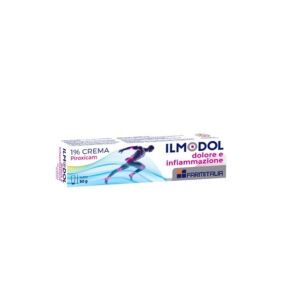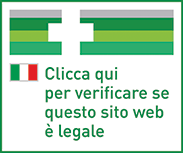Ship in Europe, Find out rates!
Language
Ilmodol Pain Inflammation Cream 1% 50g

Regular Price
€11.00
Special Price
€7.83
-29%
Save: €3.17
In stock
Recent lowest price:
€10.89
- box Delivery in Italy in 24/48 and free returns
- star3.000+ positive reviews
- dropboxOver 60,000 products in the catalog
NAME
ARTROXICAM
PHARMACOTHERAPEUTIC CATEGORY
Topical medications for joint and muscle pain.
ACTIVE PRINCIPLES
Piroxicam.
EXCIPIENTS
Cream 1%: polyethylene glycol cetyl ether, polyglycol esters with fatty acids, cetostearyl alcohol, propylene glycol, sodium citrate, citric acid, benzyl alcohol, purified water. Skin foam 1%: propylene glycol, hydrochloric acid, sodium hydroxide, monobasic sodium phosphate monohydrate, nicotinamide, polysorbate 80, povidone, ethyl alcohol, benzyl alcohol, lavender essence, nerolene essence, purified water. Propellant: propane-butane-isobutane.
INDICATIONS
Painful and inflammatory states of a rheumatic or traumatic nature of the joints, muscles, tendons and ligaments.
CONTRAINDICATIONS / SECONDARY EFFECT
Hypersensitivity 'to the active substance or to any of the excipients.
DOSAGE
Adults: apply to the skin 2-3 times of 3-5 cm of cream or foam or more depending on the extent of the affected part, massaging gently to promote absorption. Skin foam 1%: remove the protective cap; dispense the foam on the affected part and close again.
STORAGE
1% cream: this medicine does not require any special storage conditions. Skin foam 1%: the container under pressure must not be punctured, it must not be approached, even if empty, to sources of heat, do not freeze and protect the medicine from direct sunlight. Do not expose to temperatures above 50 degrees C.
WARNINGS
The quantity of active principle absorbed through the skin does not normally reach concentrations in circulation such as to make the warnings valid and expose to the risk of side effects related to the administration of the drug systemically. The application of products for topical use, especially if prolonged, can give rise to sensitization phenomena. In the presence of hypersensitivity reactions, treatment must be interrupted and appropriate therapy instituted. Serious skin reactions, some of them life-threatening, such as exfoliative dermatitis, Stevens-Johnson syndrome (SJS) and toxic epidermal necrolysis (TEN) have been reported with the use of piroxicam for systemic use. These reactions have not been associated with topical piroxicamper use, however the possibility that they may occur with topical administration cannot be excluded. Patients should be informed of the signs and symptoms, and they should also be closely monitored for skin reactions. The highest risk of developing SJS and TEN occurs in the first weeks of treatment.If symptoms and signs of SJS or TEN occur (e.g. progressive rash often with blistering or mucosal lesions) treatment with piroxicam should be suspended. The best results in the management of SJS and TEN are obtained with early diagnosis and immediate discontinuation of therapy with any suspect drug. Early withdrawal is associated with a better prognosis. If the patient has developed SJS or TEN with the use of the drug, it should no longer be used in this patient. Non-steroidal anti-inflammatory drugs, including piroxicam, can cause interstitial nephritis, nephrotic syndrome, and kidney failure. There have also been reports of interstitial nephritis, nephrotic syndrome and renal failure with topical piroxicam, although a causal relationship with topical piroxicam treatment has not been established. Consequently, it cannot be excluded that these adverse events may be related to the use of topical piroxicam. The cream contains cetostearyl alcohol. This substance can cause local skin reactions (eg contact dermatitis).
INTERACTIONS
Based on bioavailability studies, piroxicam cream or foam is extremely unlikely to displace other plasma protein bound drugs. However, doctors will need to monitor patients treated with the drug (cream or foam) and high protein binding drugs for any dose adjustments.
SIDE EFFECTS
Like all medicines, the medicine can cause side effects, although not everybody gets them. The use, especially if prolonged, of the product can give rise to sensitization phenomena and local irritation. Skin and subcutaneous system disorders. Rare: urticaria (immediate reaction). In this case it is necessary to interrupt the treatment; very rare: bullous reactions such as Stevens Johnson Syndrome and toxic epidermal necrolysis; Not known: contact dermatitis, eczema and photosensitivity skin reactions. Respiratory, thoracic and mediastinal disorders. Rare: bronchospasm (immediate reaction). In this case, the treatment must be stopped. The reporting of suspected adverse reactions that occur after the authorization of the drug is important, as it allows continuous monitoring of the benefit / risk ratio of the drug.
PREGNANCY AND BREASTFEEDING
Based on the mechanism of action, the use of NSAIDs, including piroxicam, may delay or prevent rupture of ovarian follicles, which in some women has been associated with reversible infertility. In women with difficulty in conceiving or undergoing investigation for infertility, the suspension of NSAIDs, including piroxicam, should be considered. The amount of active ingredient absorbed through the skin does not normally reach, in the circulation, concentrations such as to make the warnings valid, and to expose to the risk of undesirable effects related to the administration of the drug systemically. However, as a precaution, unless your doctor considers it absolutely necessary, it is not recommended for use during pregnancy. Inhibition of prostaglandin synthesis could adversely affect pregnancy. Data from epidemiological studies suggest an increased risk of miscarriage after the use of prostaglandin synthesis inhibitors in early pregnancy. In animals, administration of prostaglandin synthesis inhibitors has been shown to cause increased pre and post loss. -plant. The use of topical piroxicam during breastfeeding is not recommended as its clinical safety has not been evaluated.
ARTROXICAM
PHARMACOTHERAPEUTIC CATEGORY
Topical medications for joint and muscle pain.
ACTIVE PRINCIPLES
Piroxicam.
EXCIPIENTS
Cream 1%: polyethylene glycol cetyl ether, polyglycol esters with fatty acids, cetostearyl alcohol, propylene glycol, sodium citrate, citric acid, benzyl alcohol, purified water. Skin foam 1%: propylene glycol, hydrochloric acid, sodium hydroxide, monobasic sodium phosphate monohydrate, nicotinamide, polysorbate 80, povidone, ethyl alcohol, benzyl alcohol, lavender essence, nerolene essence, purified water. Propellant: propane-butane-isobutane.
INDICATIONS
Painful and inflammatory states of a rheumatic or traumatic nature of the joints, muscles, tendons and ligaments.
CONTRAINDICATIONS / SECONDARY EFFECT
Hypersensitivity 'to the active substance or to any of the excipients.
DOSAGE
Adults: apply to the skin 2-3 times of 3-5 cm of cream or foam or more depending on the extent of the affected part, massaging gently to promote absorption. Skin foam 1%: remove the protective cap; dispense the foam on the affected part and close again.
STORAGE
1% cream: this medicine does not require any special storage conditions. Skin foam 1%: the container under pressure must not be punctured, it must not be approached, even if empty, to sources of heat, do not freeze and protect the medicine from direct sunlight. Do not expose to temperatures above 50 degrees C.
WARNINGS
The quantity of active principle absorbed through the skin does not normally reach concentrations in circulation such as to make the warnings valid and expose to the risk of side effects related to the administration of the drug systemically. The application of products for topical use, especially if prolonged, can give rise to sensitization phenomena. In the presence of hypersensitivity reactions, treatment must be interrupted and appropriate therapy instituted. Serious skin reactions, some of them life-threatening, such as exfoliative dermatitis, Stevens-Johnson syndrome (SJS) and toxic epidermal necrolysis (TEN) have been reported with the use of piroxicam for systemic use. These reactions have not been associated with topical piroxicamper use, however the possibility that they may occur with topical administration cannot be excluded. Patients should be informed of the signs and symptoms, and they should also be closely monitored for skin reactions. The highest risk of developing SJS and TEN occurs in the first weeks of treatment.If symptoms and signs of SJS or TEN occur (e.g. progressive rash often with blistering or mucosal lesions) treatment with piroxicam should be suspended. The best results in the management of SJS and TEN are obtained with early diagnosis and immediate discontinuation of therapy with any suspect drug. Early withdrawal is associated with a better prognosis. If the patient has developed SJS or TEN with the use of the drug, it should no longer be used in this patient. Non-steroidal anti-inflammatory drugs, including piroxicam, can cause interstitial nephritis, nephrotic syndrome, and kidney failure. There have also been reports of interstitial nephritis, nephrotic syndrome and renal failure with topical piroxicam, although a causal relationship with topical piroxicam treatment has not been established. Consequently, it cannot be excluded that these adverse events may be related to the use of topical piroxicam. The cream contains cetostearyl alcohol. This substance can cause local skin reactions (eg contact dermatitis).
INTERACTIONS
Based on bioavailability studies, piroxicam cream or foam is extremely unlikely to displace other plasma protein bound drugs. However, doctors will need to monitor patients treated with the drug (cream or foam) and high protein binding drugs for any dose adjustments.
SIDE EFFECTS
Like all medicines, the medicine can cause side effects, although not everybody gets them. The use, especially if prolonged, of the product can give rise to sensitization phenomena and local irritation. Skin and subcutaneous system disorders. Rare: urticaria (immediate reaction). In this case it is necessary to interrupt the treatment; very rare: bullous reactions such as Stevens Johnson Syndrome and toxic epidermal necrolysis; Not known: contact dermatitis, eczema and photosensitivity skin reactions. Respiratory, thoracic and mediastinal disorders. Rare: bronchospasm (immediate reaction). In this case, the treatment must be stopped. The reporting of suspected adverse reactions that occur after the authorization of the drug is important, as it allows continuous monitoring of the benefit / risk ratio of the drug.
PREGNANCY AND BREASTFEEDING
Based on the mechanism of action, the use of NSAIDs, including piroxicam, may delay or prevent rupture of ovarian follicles, which in some women has been associated with reversible infertility. In women with difficulty in conceiving or undergoing investigation for infertility, the suspension of NSAIDs, including piroxicam, should be considered. The amount of active ingredient absorbed through the skin does not normally reach, in the circulation, concentrations such as to make the warnings valid, and to expose to the risk of undesirable effects related to the administration of the drug systemically. However, as a precaution, unless your doctor considers it absolutely necessary, it is not recommended for use during pregnancy. Inhibition of prostaglandin synthesis could adversely affect pregnancy. Data from epidemiological studies suggest an increased risk of miscarriage after the use of prostaglandin synthesis inhibitors in early pregnancy. In animals, administration of prostaglandin synthesis inhibitors has been shown to cause increased pre and post loss. -plant. The use of topical piroxicam during breastfeeding is not recommended as its clinical safety has not been evaluated.


